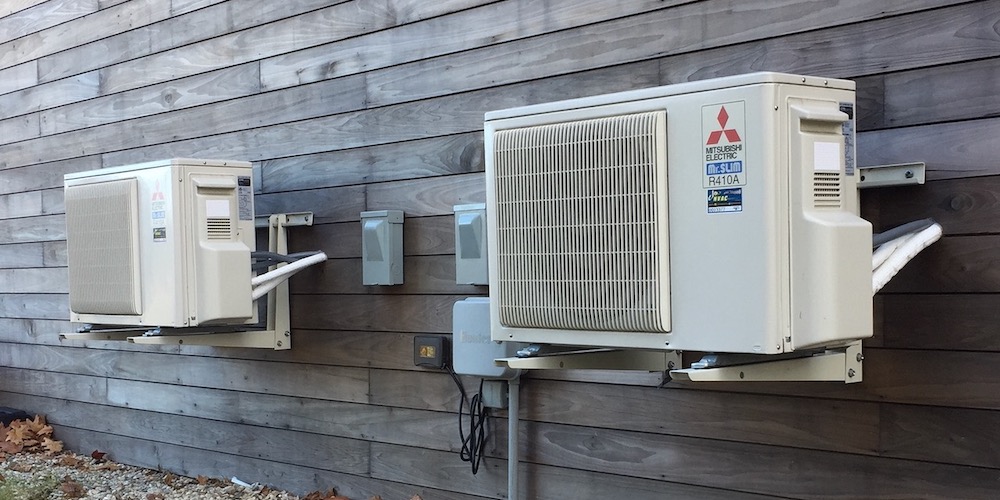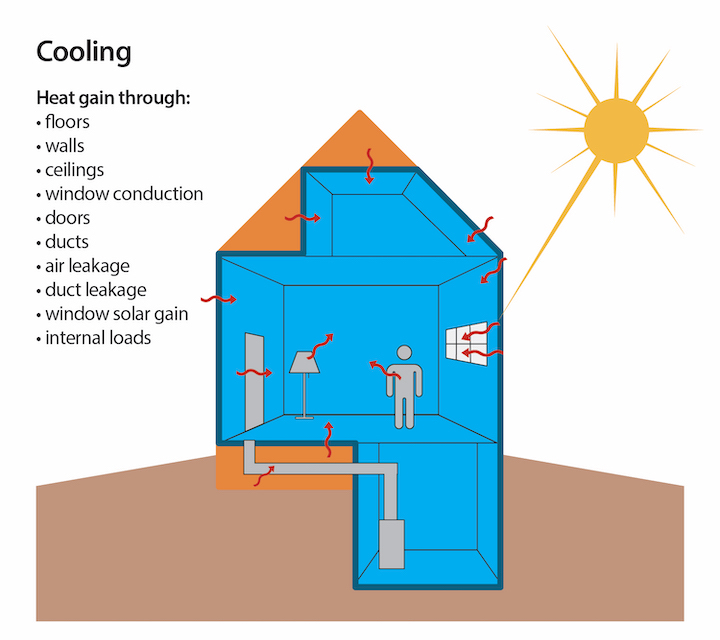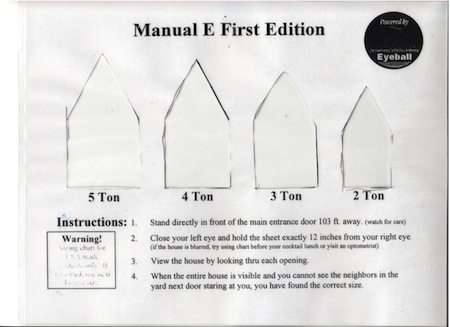The 3 Types of Heating and Cooling Loads

What is it about the number three? You’ve got the Three Musketeers, the Three Little Pigs, and the Three Stooges. Then there’s three strikes (what every pitcher wants), three branches of government (executive, legislative, and judicial), and the three kinds of people (those who can do math and those who can’t). And let’s not forget three on a match, three wise men, and threepeats. Today we’ll look at another big three: the three types of heating and cooling loads. Do you know what they are?
Load vs. capacity
Before we get into the three types of heating and cooling loads, though, it’s a good idea to make sure we’re all clear on the difference between two words that are easy to confuse: load and capacity. If you’re new to HVAC lingo, it’s easy to miss the distinction so here it is:
Load – the amount of heating or cooling a building needs
Capacity – the amount of heating or cooling a piece of HVAC equipment can provide
Whenever you see the word “load” in the context of heating and cooling, it refers to the building’s needs. When you see “capacity,” it’s what the heating or cooling equipment can provide.
Got it? Great. Let’s get to those three types of loads now, knowing that we’re talking about building needs.
Design load
If you ask a competent HVAC designer what the cooling load on a house is and they tell you it’s two tons, they’re talking about the design load. That means they’ve calculated the amount of cooling needed for the house using plans and specifications for the house or actual field data for existing homes. Mostly the inputs in the calculation are constant (e.g., insulation R-value, house orientation…), but some things change throughout the day or year (e.g., outdoor temperatures) and some can be changed by the occupants (e.g., indoor temperatures).

Calculation protocols like ACCA Manual J specify the temperatures you should use in the calculations, and these are called the design conditions. For example, our outdoor summer design temperature in Atlanta is 92° F. ACCA’s recommended indoor summer design temperature is 75° F. For winter, Atlanta’s numbers are 23° F and 70° F.
So your design cooling load is how much air conditioning you need when the indoor and outdoor temperatures are at the summer design levels. The design heating load is how much heating you need when the indoor and outdoor temperatures are at the winter design levels.
Extreme load
Unless you live in a place like Santa Monica, California — where the temperature is always perfect — you probably understand that design loads are simply a guide. A house will never spend a whole lot of time subjected to design conditions, so if you size your heating and cooling equipment to meet the design loads exactly, you’ll have the wrong size equipment most of the time.
Extreme loads happen when you get the hottest or coldest temperatures your location experiences. In Atlanta, we got down to single digits Fahrenheit last year, nearly 20 F° below our design temperature. In the summer of 2012, we set a record with a high temperature of 106° F. Should we install HVAC equipment with the capacity to meet the loads from such extreme temperatures?
The answer is no. First, if you do a Manual J load calculation accurately, it’s got some built in padding. The loads you calculate will probably be 15-20% higher than the actual load at design conditions, which gives you a buffer to help meet the extreme loads.
Second, unless you live in a leaky, uninsulated sieve of a house, there will be a lag between when the extreme temperatures occur outdoors and when the inside of the house feels the effects. By the time the heat from that 106° F day starts getting to the inside of the house, the outdoor temperature has already dropped. That’s one of the ways insulation and air sealing help you.
Third, extreme temperatures occur for about 1% of the time on average. Yes, there will be years with heat waves and years with cold spells, but HVAC equipment sized according to the design loads and ACCA’s Manual S equipment selection protocol should cover you for most of the extreme loads you experience.
Extreme loads get more attention than they deserve, in my opinion. If you’ve got a home that’s adequately air-sealed and insulated, properly sized equipment should do fine. If your home isn’t air-sealed or insulated well enough and your HVAC equipment can’t keep up, attack the building enclosure and distribution system before installing bigger equipment. (For more on what you can do if your equipment doesn’t keep up, see the article I wrote shortly after we set the high temperature record in Atlanta, 9 Uncommon Tips for Keeping Cool with a Struggling Air Conditioner.)
Part load
Extreme loads always seem to get the spotlight, but part load conditions are actually more deserving of your attention. For nearly 99% of the time, the outdoor temperatures will be less extreme than the design temperatures for your location. Think about it. You get up on a summer morning, look at the thermometer, and see that it’s 73° F outdoors. Maybe it’ll climb up to your design temperature in the afternoon, but even then, it won’t stay there very long.
So even on a day when you hit the design temperature, your heating or air conditioning system will be operating under part-load conditions most of the day. Another factor is the seasonal change in conditions during the cooling or heating seasons. Early and late in the season, every day will be a part-load day.
The problem with part-load conditions is that most heating and cooling equipment operates at fixed capacity. If the cooling load is only 6000 BTU per hour and you have a 24,000 BTU/hour air condtioner, that AC isn’t going to run very long before it meets the thermostat setpoint. That imbalance isn’t ideal for comfort or dehumidification.
As houses get more airtight and better insulated, the imbalance gets worse. With fixed capacity equipment that comes in minimum capacities of 1.5 tons for air conditioners or 30-40 thousand BTU/hr for furnaces, it’s easy to have equipment that may never come near needing its full capacity in small, energy efficient homes. Then if you overventilate by trying to follow the guidelines of a standard like ASHRAE 62.2-2013, you may end up growing mold in a humid climate.
Yes, there are ways around the problems. You can put in some supplemental dehumidification or use two-stage heating and cooling equipment. Or you could go a step further and put in fully modulating equipment like mini-split heat pumps. It’s important to understand the nuances of heating and cooling loads and the ramifications of the type of equipment you choose. The HVAC design world isn’t as simple as it used to be back when you could use rules of thumb or silly protocols like Manual E (shown below). Actually, it never was that simple.

The hip bone’s still connected to the thigh bone, which is still connected to the knee bone. That’s three things, so I hope that means I’m in the group that can do math!
Allison A. Bailes III, PhD is a speaker, writer, building science consultant, and the founder of Energy Vanguard in Decatur, Georgia. He has a doctorate in physics and is the author of a popular book on building science. He also writes the Energy Vanguard Blog. For more updates, you can subscribe to our newsletter and follow him on LinkedIn.
Related Articles
We Are the 99% — Design Temperatures & Oversized HVAC Systems
3 Reasons Your 3 Ton Air Conditioner Isn’t Really 3 Tons
Learn the Lingo – Air Conditioning Terminology & Tidbits
Why Is Air Conditioner Capacity Measured in Tons?
Image of heat gains on a summer day from ACCA Manual J.
NOTE: Comments are moderated. Your comment will not appear below until approved.
This Post Has 14 Comments
Comments are closed.

Allison, <br /
Allison, <br />Thanks for a superb article. I find AC companies constantly trying to oversize systems in new homes. It seems that most Manual J’s have a built in default to a ton per 500 sf. I will be passing this article on to clients to help them understand why too much AC is harmful in today’s tight homes. <br />I encourage every one of my client’s to upgrade to a 2 stage condensing unit with a variable speed fancoil. I’m not yet persuaded that the true variable speed mini-split system, even with some ducting, will deliver the air distribution to which we Americans are accustomed. <br />Thanks again for a superb article.
Perfectly stated once again
Perfectly stated once again Allison, <br />There’s been a lot of chatter of late about over-sizing furnaces and air conditioners, and hopefully our mechanical contractors are getting more confident in home performance so they reduce capacity of the equipment to meet the actual load. As you point out, even a well designed system is over-sized most of the time unless it’s capable of varying it’s capacity, which is the wave of the future. <br />As we improve our heating and cooling systems and fit them carefully to the home or building loads it’s imperative to consider th "V" in HVAC separately. As our H & AC loads shrink it’s more and more common to require a second air distribution system for ventilation in order to get the air to and from the critical areas in the home. <br />Whatever it takes we must Build it Tight and Ventilate Right, Build it Tight and Ventilate Right, Build it Tight and Ventilate Right!
IMHO Man J doesn’t give
IMHO Man J doesn’t give enough credit for "thermal lag". It affects peak load considerably on high mass buildings.
Thanks for this. I’m looking
Thanks for this. I’m looking to install A/C this year and got some quotes in the fall. Out of 3 companies, only one said a 1.5 ton condenser would be fine. Everyone else wanted to install a 2 ton unit for a 1000 square foot house that has R-49 (foam/cellulose) in the attic. I went so far as to purchase software and do my own manual J and sure enough, 1.5 tons is plenty.
At NESEA’s BuildingEnergy
At NESEA’s BuildingEnergy conference in Boston last year, Jonathan Wright told the story of moving into one of his own high performance homes in the midst of a severe winter storm. He promptly lost power for 3 days with outside temps in the 20’s. After 3 days, his indoor house temperature drifted from 68 down to 65. <br />That’s the kind of design load we should be striving for, with variable capacity equipment to match.
Allison,
Allison,
Thanks for a superb article. I find AC companies constantly trying to oversize systems in new homes. It seems that most Manual J’s have a built in default to a ton per 500 sf. I will be passing this article on to clients to help them understand why too much AC is harmful in today’s tight homes.
I encourage every one of my client’s to upgrade to a 2 stage condensing unit with a variable speed fancoil. I’m not yet persuaded that the true variable speed mini-split system, even with some ducting, will deliver the air distribution to which we Americans are accustomed.
Thanks again for a superb article.
Perfectly stated once again
Perfectly stated once again Allison,
There’s been a lot of chatter of late about over-sizing furnaces and air conditioners, and hopefully our mechanical contractors are getting more confident in home performance so they reduce capacity of the equipment to meet the actual load. As you point out, even a well designed system is over-sized most of the time unless it’s capable of varying it’s capacity, which is the wave of the future.
As we improve our heating and cooling systems and fit them carefully to the home or building loads it’s imperative to consider th “V” in HVAC separately. As our H & AC loads shrink it’s more and more common to require a second air distribution system for ventilation in order to get the air to and from the critical areas in the home.
Whatever it takes we must Build it Tight and Ventilate Right, Build it Tight and Ventilate Right, Build it Tight and Ventilate Right!
IMHO Man J doesn’t give
IMHO Man J doesn’t give enough credit for “thermal lag”. It affects peak load considerably on high mass buildings.
Thanks for this. I’m looking
Thanks for this. I’m looking to install A/C this year and got some quotes in the fall. Out of 3 companies, only one said a 1.5 ton condenser would be fine. Everyone else wanted to install a 2 ton unit for a 1000 square foot house that has R-49 (foam/cellulose) in the attic. I went so far as to purchase software and do my own manual J and sure enough, 1.5 tons is plenty.
At NESEA’s BuildingEnergy
At NESEA’s BuildingEnergy conference in Boston last year, Jonathan Wright told the story of moving into one of his own high performance homes in the midst of a severe winter storm. He promptly lost power for 3 days with outside temps in the 20’s. After 3 days, his indoor house temperature drifted from 68 down to 65.
That’s the kind of design load we should be striving for, with variable capacity equipment to match.
We have been installing
We have been installing radiant floors and panels with combi service condensing storage water heaters for over 20 years now and over the last 10 a sub-system that modulates flow on outdoor reset. <br /> <br />An ERV, high velocity AC and mini-splits round out the package, but all are sized to ACCA Manual ‘J’; every one.
We have been installing
We have been installing radiant floors and panels with combi service condensing storage water heaters for over 20 years now and over the last 10 a sub-system that modulates flow on outdoor reset.
An ERV, high velocity AC and mini-splits round out the package, but all are sized to ACCA Manual ‘J’; every one.
Hi Allison,
Hi Allison,
Great blogs. very helpful in understanding the basics of HVAC design. I am living in Texas. as you can imaging humidity is the biggest evil associated with our weather. Our old HVAC system has been working overtime to keep our house cool and thus has been needing service every year. So we decided to have with the recommendation of our HVAC contractor, the system upgraded to a new unit. The new unit has been great. However, lately I have noticed it is running more than it has to and cannot keep the temperature more than 1 degree below the setpoint. even when it satisfies the setting, it cools very rapidly. We installed a 3.5 ton unit based on a Manual J load calc which is an upsize from a previous 3 ton unit . Now my impression is that the load calc was gamed and no duct testing was done at all. I think the contractor gave the impression that a bigger unit would cool better. Now I have a 90k 4 ton drive furnace which i think is more oversized than the a/c. homne is about 1614 sq ft. so thoughts ? Am I using an oversized system on undersized ductwork or is just the blower that is too big?
Hi Allison,
Hi Allison,
Great blogs. very helpful in understanding the basics of HVAC design. I am living in Texas. as you can imaging humidity is the biggest evil associated with our weather. Our old HVAC system has been working overtime to keep our house cool and thus has been needing service every year. So we decided to have with the recommendation of our HVAC contractor, the system upgraded to a new unit. The new unit has been great. However, lately I have noticed it is running more than it has to and cannot keep the temperature more than 1 degree below the setpoint. even when it satisfies the setting, it cools very rapidly. We installed a 3.5 ton unit based on a Manual J load calc which is an upsize from a previous 3 ton unit . Now my impression is that the load calc was gamed and no duct testing was done at all. I think the contractor gave the impression that a bigger unit would cool better. Now I have a 90k 4 ton drive furnace which i think is more oversized than the a/c. homne is about 1614 sq ft. so thoughts ? Am I using an oversized system on undersized ductwork or is just the blower that is too big?